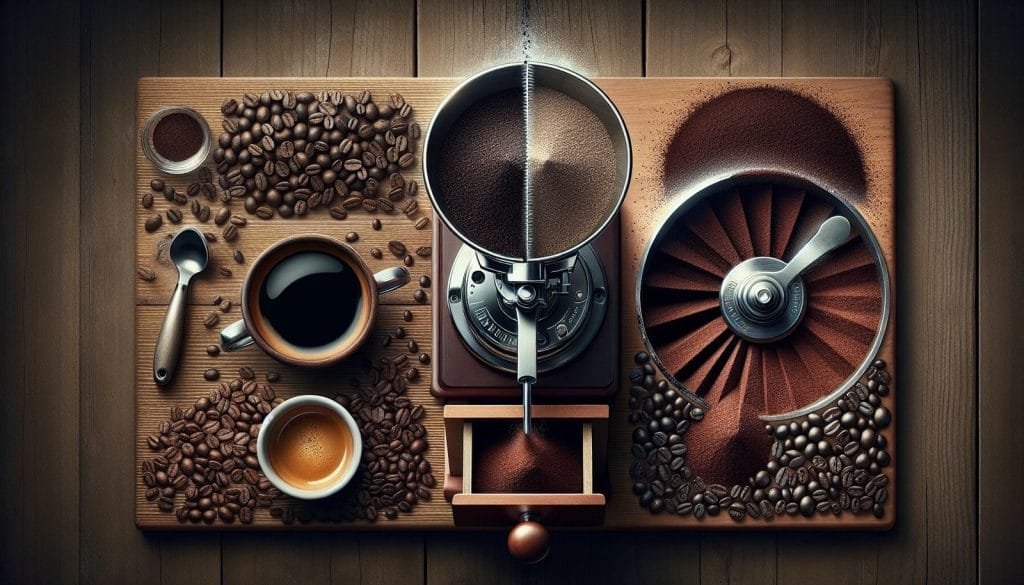Espresso, renowned for its strong and concentrated flavor, is a beloved beverage among coffee enthusiasts. However, the process of achieving that perfect espresso shot can be quite intricate, beginning with the grinding of coffee beans to a precise consistency. But what if you already have pre-ground coffee at your disposal? Can you rely on this already-ground coffee to create a delectable espresso? In this article, we will explore the potential of using ground coffee for espresso, delving into the factors that influence the outcome and whether it can truly match the quality obtained from freshly ground beans.
Can You Grind Ground Coffee For Espresso?
Understanding the Basics of Espresso
Espresso is a highly concentrated form of coffee that is brewed using high pressure and finely ground coffee beans. It is known for its rich flavor, strong aroma, and velvety texture. To achieve the perfect espresso shot, it is crucial to have the right grind size of coffee beans, which can significantly impact the taste and quality of the final product.
What is Ground Coffee?
Ground coffee refers to coffee beans that have been processed and crushed into smaller particles. This allows for easier extraction of flavors during brewing. Ground coffee is commonly available in various coarseness levels, ranging from extra coarse (suitable for cold brew) to extra fine (typically used for Turkish coffee). The grind coarseness for espresso falls on the finer end of the spectrum.

The Importance of Proper Grinding for Espresso
Proper grinding is essential for espresso preparation. The extraction process in espresso relies on water passing through the compacted coffee grounds under high pressure. If the coffee grounds are too coarse, the water will flow through too quickly, resulting in a weak and under-extracted espresso shot. On the other hand, if the coffee grounds are too fine, the water flow can be restricted, leading to over-extraction and a bitter taste. Therefore, achieving an optimal grind size is crucial to produce the perfect espresso shot.
Can You Use Pre-Ground Coffee for Espresso?
While it is possible to use pre-ground coffee for espresso, it is generally not recommended for achieving the best results. Pre-ground coffee is often roasted and ground for generic brewing methods like drip coffee or French press, which require a coarser grind. The finer grind size required for espresso extraction is often not achieved in pre-ground coffee packaging.

Problems with Using Pre-Ground Coffee
Using pre-ground coffee for espresso can lead to several issues. Firstly, the coarser grind size means that the water will flow through the coffee grounds too quickly, resulting in a weak and watery espresso shot. Additionally, pre-ground coffee may have lost some of its freshness and flavor due to prolonged exposure to air, leading to a less vibrant and enjoyable espresso experience. Lastly, since pre-ground coffee is not specifically ground for espresso, it may not have the desired consistency and uniformity in particle size, leading to inconsistent extraction and potentially clogging the espresso machine.
Options for Grinding Coffee for Espresso
To ensure the best possible espresso experience, it is highly recommended to grind coffee beans specifically for espresso. This can be done by using a coffee grinder at home or by visiting a coffee shop that offers grinding services. Investing in a coffee grinder allows you to have full control over the grind size, freshness, and quality of the coffee beans.
Burr Grinders vs. Blade Grinders
When it comes to coffee grinders, there are two main types: burr grinders and blade grinders. Burr grinders are generally considered superior for espresso grinding due to their ability to produce a consistent grind size. They work by crushing the coffee beans between two burrs, resulting in a uniform size and shape of coffee grounds. Blade grinders, on the other hand, use spinning blades to chop the coffee beans, which can result in an uneven grind size. While blade grinders may be more affordable, they are often not recommended for brewing espresso.
Optimal Grind Size for Espresso
The optimal grind size for espresso falls within the range of fine to very fine. The particles should be small enough to allow water to pass through with enough pressure to extract the desired flavors and oils. It is recommended to aim for a grind size similar to table salt or slightly finer. Experimentation with grind size may be necessary to achieve the perfect balance between extraction and taste.
Tips for Grinding Coffee for Espresso
When grinding coffee for espresso, there are a few tips to keep in mind. Firstly, ensure that your coffee grinder is clean and free from any residue that could affect the coffee flavor. Secondly, grind the coffee beans immediately before brewing to preserve their freshness and aroma. Finally, consider adjusting the grind size based on the particular espresso machine and beans you are using, as different combinations may require slight adjustments to achieve the optimal extraction.
Other Considerations for Making Espresso
In addition to grinding coffee beans to the correct size, there are other factors to consider when making espresso. It is important to use the right water temperature, typically between 195°F and 205°F, to extract the flavors properly. Additionally, the coffee-to-water ratio should be carefully measured to ensure a balanced and flavorful espresso shot. Lastly, proper tamping of the coffee grounds in the portafilter is crucial to create a consistent and even surface for water to flow through.
In conclusion, grinding coffee specifically for espresso is highly recommended to achieve the best results. While pre-ground coffee can be used in a pinch, it often falls short in terms of grind coarseness and freshness. Investing in a quality burr grinder and experimenting with grind size can significantly enhance the flavor and quality of your espresso shots. With attention to detail and proper technique, you can enjoy a rich and aromatic espresso experience right in the comfort of your home.




